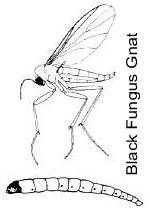 Controlling Fungus Gnats - March 3, 2004 Jeff Schalau, County Director, Agent, Agriculture & Natural Resources Arizona Cooperative Extension, Yavapai County Fungus gnats are delicate, gray, dark-gray, or black mosquito-like insects about 1/10 to 1/8 inch long. You may see them on the soil in potted plants and other wet areas or hovering around lights and bright windows. The adults do not bite or damage plants and are usually considered a nuisance insect. They often appear at this time of year because we tend to over water our houseplants in the winter. This moist environment creates a perfect breeding ground for fungus gnats. The female fungus gnat lays between 100 to 300 eggs in batches of 2 to 30 each in decaying organic matter. Eggs are hardly visible without magnification and hatch within four to six days. Fungus gnat larvae often live in potted plants (potting soil is decaying organic matter). They are white, translucent maggots with shiny black heads and can reach 1/4 inch in length. They may also feed on plant roots and are known to injure the roots of bedding plants, African violets, carnations, cyclamens, geraniums, poinsettias and foliage plants. The larval stage lasts about 12 to 14 days. Plant symptoms may appear as sudden wilting, loss of vigor, poor growth, yellowing and foliage loss. Pupae are silk-like cocoons in the soil and adults emerge in five to six days. Simple prevention measures can minimize the chances of bringing these insects into your home. Inspect plants carefully before purchase for signs of insect infestation. Always use sterile potting soil to prevent introduction of fungus gnats. Overwatering, water leaks and poor drainage may result in buildup of fungus gnats. Allowing the soil to dry as much as possible between watering is effective in killing many maggots. Houseplants taken outside during warm weather may become infested with insects before being brought back indoors. Practice good sanitation. Control measures include insecticides and repotting (or rerooting) infested plants. I do not recommend the use of chemical insecticides in the home. Especially for fungus gnats which are usually nuisance pests and not usually that numerous in our arid environment. A biological insecticide, Bacillus thuringiensis var. israelensis (Bti), is a safer alternative to chemicals and can be applied to the soil of infested plants. Yellow sticky cards attract fungus gnats and are often used for monitoring. Placement of several yellow sticky cards may also be somewhat effective in controlling fungus gnats. Electrocutor-light fly traps will attract and kill adult fungus gnats at night. Decoy pots of sprouting grain (barley, wheat, oats, etc.) can be used to attract adult females and trick them into laying their eggs. Every two weeks, the grain should be boiled and discarded to kill eggs and larvae. Before you launch a control campaign for any pest, remember the four steps of integrated pest management (IPM). These are: 1) correct identification of pest; 2) monitor for damage (or nuisance) threshold; 3) once the threshold is reached, apply multiple prevention and control measures; and 4) monitor for control effectiveness and revise strategy if needed. IPM is a standard approach for minimizing damage from any pest species. All gardeners would do well to memorize these steps and use them whenever pest issues arise. The key points are correct pest species identification and accepting some damage before control measures are applied. If you jump the gun and apply pesticides before a damage threshold is reached, you will most certainly kill some beneficial (predators and parasites) or benign insects. The University of Arizona Cooperative Extension has publications and information on gardening and pest control. If you have other gardening questions, call the Master Gardener line in the Cottonwood office at 646-9113 ext. 14 or E-mail us at mgardener@verdeonline.com and be sure to include your address and phone number. Find past Backyard Gardener columns or submit column ideas at the Backyard Gardener web site: http://cals.arizona.edu/yavapai/anr/hort/byg/. |